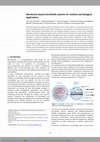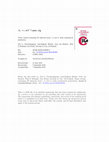Papers by Jean-Baptiste Blondé

Microfluidic devices with integrated membranes that enable control of mass transport in constrain... more Microfluidic devices with integrated membranes that enable control of mass transport in constrained environments have shown considerable growth over the last decade. Membranes are a key component in several industrial processes such as chemical, pharmaceutical, biotechnological, food, and metallurgy separation processes as well as waste management applications, allowing for modular and compact systems. Moreover, the miniaturization of a process through microfluidic devices leads to process intensification together with reagents, waste and cost reduction, and energy and space savings. The combination of membrane technology and microfluidic devices allows therefore magnification of their respective advantages, providing more valuable solutions not only for industrial processes but also for reproducing biological processes. This review focuses on membrane-based microfluidic devices for biomedical science with an emphasis on microfluidic artificial organs and organs-on-chip. We provide the basic concepts of membrane technology and the laws governing mass transport. The role of the membrane in biomedical microfluidic devices, along with the required properties, available materials, and current challenges are summarized. We believe that the present review may be a starting point and a resource for researchers who aim to replicate a biological phenomenon on-chip by applying membrane technology, for moving forward the biomedical applications.
Alle rechten voorbehouden. Niets uit deze uitgave mag worden vermenigvuldigd, in enige vorm of op... more Alle rechten voorbehouden. Niets uit deze uitgave mag worden vermenigvuldigd, in enige vorm of op enige wijze, zonder voorafgaande schriftelijke toestemming van de auteur.
Here, we report a breast tumour-on-a-chip platform to evaluate the penetration of nanomedicines i... more Here, we report a breast tumour-on-a-chip platform to evaluate the penetration of nanomedicines in 3D tumour spheroids, as a function of the tumour spheroid cellular composition. Mouse multicellular tumour mono-culture spheroids and cancer cell-fibroblast co-culture spheroids were exposed to silica nanoparticles (NPs) (30 or 100nm) or liposomes (100nm) at various flowrates, mimicking the shear stress levels found in vivo. Results revealed that the NP penetration was influenced by the shear stress, and that the presence of fibroblasts in the tumour spheroids greatly reduced the penetration depth of the nanoparticles.
Here, we report a breast tumour-on-a-chip platform to evaluate the penetration of nanomedicines i... more Here, we report a breast tumour-on-a-chip platform to evaluate the penetration of nanomedicines in 3D tumour spheroids, as a function of the tumour spheroid cellular composition. Mouse multicellular tumour mono-culture spheroids and cancer cell-fibroblast co-culture spheroids were exposed to silica nanoparticles (NPs) (30 or 100nm) or liposomes (100nm) at various flowrates, mimicking the shear stress levels found in vivo. Results revealed that the NP penetration was influenced by the shear stress, and that the presence of fibroblasts in the tumour spheroids greatly reduced the penetration depth of the nanoparticles.
24th International Conference on Miniaturized Systems for Chemistry and Life Sciences, µTAS 2020, 2020
NanoBioTech-Montreux 2019, 2019
Here, we report a breast tumour-on-a-chip platform to evaluate the penetration of nanomedicines i... more Here, we report a breast tumour-on-a-chip platform to evaluate the penetration of nanomedicines in 3D tumour spheroids, as a function of the tumour spheroid cellular composition. Mouse multicellular tumour mono-culture spheroids and cancer cell-fibroblast co-culture spheroids were exposed to silica nanoparticles (NPs) (30 or 100nm) or liposomes (100nm) at various flowrates, mimicking the shear stress levels found in vivo. Results revealed that the NP penetration was influenced by the shear stress, and that the presence of fibroblasts in the tumour spheroids greatly reduced the penetration depth of the nanoparticles.
Here, we report a superstructure of self-assembled chiral nematic microspheres of well-defined si... more Here, we report a superstructure of self-assembled chiral nematic microspheres of well-defined size that can distribute incoming light in any direction, while displaying high selectivity for the color and chi-rality of the incoming light. The cross-communication between the droplets can be tuned, both gradually in wavelength and reversibly in polarization.1 Monodisperse droplets are produced using a microfluidic device, and this monodispersity promotes the self-assembly of the droplets into hexagonal superstruc-tures, where they communicate optically with high selectivity for the color and chirality of light.
Here, we report on ultrasound mediated microbubble activation for efficient and deep delivery of ... more Here, we report on ultrasound mediated microbubble activation for efficient and deep delivery of nanomedicines in co-culture multicellular tumor spheroids (MCTS), in a microfluidic chip. Specifically, a tumor-on-a-chip platform was realized by trapping multi-cellular tumor spheroids in a microfluidic chamber. Microbubbles and nanoparticles, used as models for nanomedicines, were perfused continuously, the microbubbles were activated by ultrasound and the penetration of the nanoparticles was quantified. Our experiments reveal that the nanoparticle penetration sites coincide with the initial positions of the microbubbles around the spheroids.

Journal of controlled release : official journal of the Controlled Release Society, Dec 9, 2016
Nanoparticle penetration through tumor tissue after extravasation is considered as a key issue fo... more Nanoparticle penetration through tumor tissue after extravasation is considered as a key issue for tumor distribution and therapeutic effects. Most tumors possess abundant stroma, a fibrotic tissue composed of cancer-associated fibroblasts (CAFs) and extracellular matrix (ECM), which acts as a barrier for nanoparticle penetration. There is however a lack of suitable in vitro systems to study the tumor stroma penetration of nanoparticles. In the present study, we developed and thoroughly characterized a 3D co-culture spheroidal array to mimic tumor stroma and investigated the penetration of silica and PLGA nanoparticles in these spheroids. First, we examined human breast tumor patient biopsies to characterize the content and organization of stroma and found a high expression of alpha-smooth muscle actin (α-SMA; 40% positive area) and collagen-1 (50% positive area). Next, we prepared homospheroids of 4T1 mouse breast cancer cells or 3T3 mouse fibroblasts alone as well as heterospheroi...
Here, we report a breast tumour-on-a-chip platform to evaluate the penetration of nanomedicines i... more Here, we report a breast tumour-on-a-chip platform to evaluate the penetration of nanomedicines in 3D tumour spheroids, as a function of the tumour spheroid cellular composition. Mouse multicellular tumour mono-culture spheroids and cancer cell-fibroblast co-culture spheroids were exposed to silica nanoparticles (NPs) (30 or 100nm) or liposomes (100nm) at various flowrates, mimicking the shear stress levels found in vivo. Results revealed that the NP penetration was influenced by the shear stress, and that the presence of fibroblasts in the tumour spheroids greatly reduced the penetration depth of the nanoparticles.










Uploads
Papers by Jean-Baptiste Blondé